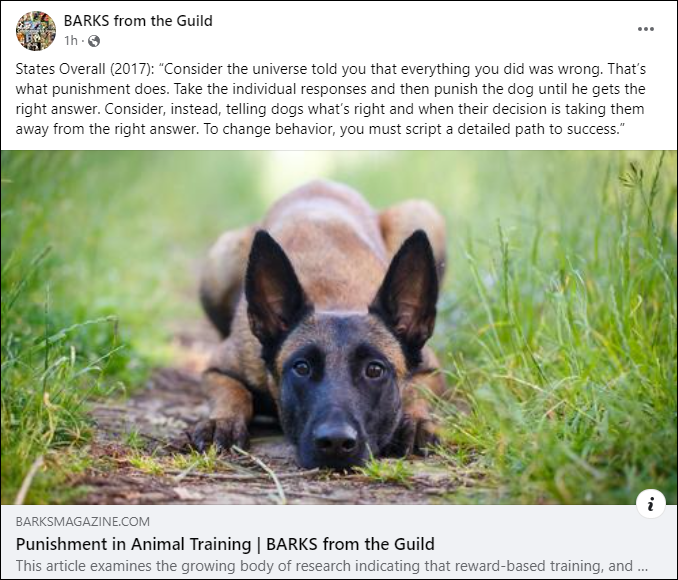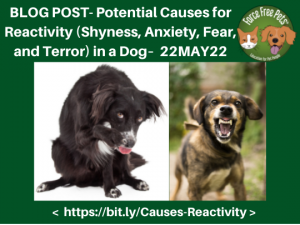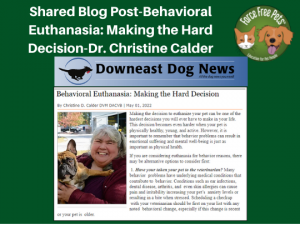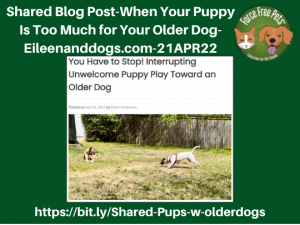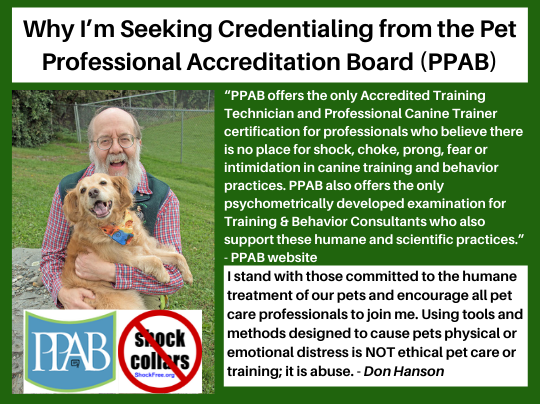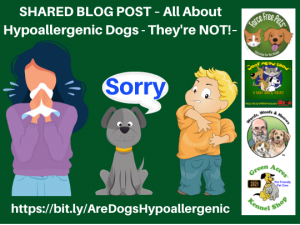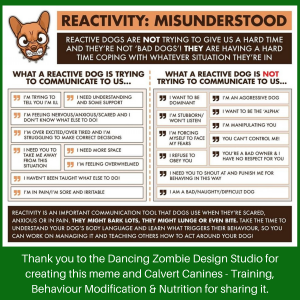If you care for animals, please read this excellent article from BARKS from the Guild on why punishment in animal training is not only totally unnecessary but also has great potential to be extremely harmful. Then share it with others, including those pet care professionals who still recommend punishment. If they choose not to read because “they know it all,” they have just demonstrated they know very little. We can stop hurting animals if we all work together and take a stand. Thank you for helping. – https://barksmagazine.com/article/punishment-in-animal-training/?
Author: Don Hanson
Potential Causes for Reactivity (Shyness, Anxiety, Fear, and Terror) in a Dog
< A short link for this page – https://bit.ly/Causes-Reactivity >
Reactivity in a dog is one of the most common reasons I see clients with behavioral concerns about their dog. Frequently, this is triggered by fear. Fear occurs on a continuum from mild shyness or timidity to anxiety, fear, and ultimately terror. Reactivity can also be caused by frustration, anger, and rage,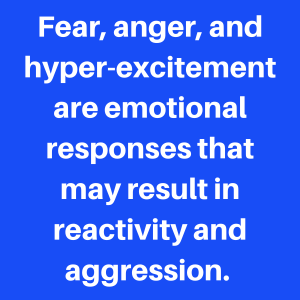 another continuum. Even positive stress, or eustress, such as happiness that leads to hyper-excitement, may cause undesirable reactivity. Fear, anger, and hyper-excitement are emotional responses that may result in reactivity and aggression. While what we call “dog training” can work well for teaching a dog to respond to a cue like sit or down, emotional responses cannot be “trained” away. When a dog or person is in an extreme emotional state, they are under stress, making learning very difficult, if not impossible. When experiencing this level of stress, the dog is under the influence of the “fight or flight response” and is solely concerned about its survival.
another continuum. Even positive stress, or eustress, such as happiness that leads to hyper-excitement, may cause undesirable reactivity. Fear, anger, and hyper-excitement are emotional responses that may result in reactivity and aggression. While what we call “dog training” can work well for teaching a dog to respond to a cue like sit or down, emotional responses cannot be “trained” away. When a dog or person is in an extreme emotional state, they are under stress, making learning very difficult, if not impossible. When experiencing this level of stress, the dog is under the influence of the “fight or flight response” and is solely concerned about its survival.
A dog can be fearful for many reasons:
Genetics – If either parent were on the fear spectrum, all of their offspring would likely be somewhere on the spectrum. Knowing if either of a dog’s parents  is fearful can be very helpful in determining how and if we can help them. If you have not already done so, I recommend talking to the breeder or the rescue or shelter where you obtained your dog. However, understand they may not have information or may misinterpret what they do know.
is fearful can be very helpful in determining how and if we can help them. If you have not already done so, I recommend talking to the breeder or the rescue or shelter where you obtained your dog. However, understand they may not have information or may misinterpret what they do know.
Medical Conditions – A medical issue can often trigger a sudden behavior change. Pain and any physical or emotional discomfort can cause behavioral changes in pets. Disorders of the nervous, endocrine, reproductive, and gastrointestinal systems can also affect your pet’s behavior.
Tick-borne diseases have become much more prevalent in Maine. A few years ago, we only needed to worry about Lyme disease. Today we also need to be concerned about Anaplasmosis, Babesiosis, Borrelia miyamotoi, Ehrlichiosis, Powassan Encephalitis, and Rocky Mountain Spotted Fever. These diseases can cause changes in behavior, including; anorexia, anxiety, confusion, depression, fatigue, malaise, and other subtle mental disorders. I have experienced this with my dog Muppy who has had Lyme disease and anaplasmosis. Both times she exhibited fearful behavior as the only sign of infection. However, once treated by her veterinarian, her behavior returned to normal.
I recommend that a veterinarian rule out any medical issues for fearful behavior before addressing it as a behavioral problem. If your veterinarian does not have experience with treating behavior, I recommend that you see Dr. Christine Calder, a Veterinary Behaviorist practicing in Maine. [ Calder Veterinary Behavior Services, (207) 298-4375, www.caldervbs.com]
Socialization – A puppy has a critical socialization and habituation period that begins when three weeks old and ends between 12 to 16 weeks of age. During this period, a puppy is typically very open to gentle exposure to novel stimuli set up to create a positive association. A puppy should always be given a choice as to whether or not they interact with someone or something. Forced interactions may cause a traumatic experience.
Ideally, you want to carefully expose a puppy to everything it will encounter in its life before they reach 12 to 16 weeks of age. However, if your puppy is acting fearfully during this period, it may be a sign of fear due to a medical issue or genetic issue, in which case I recommend you see your veterinarian immediately.
You can attempt remedial socialization after 16 weeks of age, but it requires a well-thought-out plan. This is not typically a DIY project, and I recommend you seek the services of a credentialed canine behavior consultant or a veterinary behaviorist.
Past or Recent Physical, Mental or Emotional Trauma – A dog’s brain works similar to ours; it is designed to permanently record any distressing experience in one trial to avoid that situation in the future. The next time the dog is exposed to whatever caused the trauma, it may try to flee, freeze in place, or fight if they have no other choice.
Trauma can be physical or emotional. It is vital to understand that only the dogs’ perception matters. In other words, while we might believe that something is not scary or painful, if our dog does find that “something” causes discomfort or is frightening, that is the reality from their perspective. This is a time when our opinion does not matter.
The problem with helping our dog get past a traumatic event is that we may not even know when it occurred, and the dog has no way to tell us. Nor can our dog provide us with any details about the event. For example, suppose your dog is reactive to a specific individual. It could be due to their appearance, behavior, scent, or sounds they made. It could even be due to something in the environment which your dog associated with the individual. As you can see, appearance, behavior, scent, sound, and the environment open up a wide range of possible triggers. What your dog is reacting to may even be a combination of several things, further complicating matters.
Unfortunately, we may never know what our dog fears unless we witness the triggering event. For example, my first dog suddenly became afraid of her water dish and would not drink from it or approach it. Fortunately, I did witness what happened. It was winter, and the air in our home was very dry. We were all in the living room, where the floor was covered with a thick shag carpet. My dog ran along the carpet to her steel water bowl, which was at the edge of the carpet in the dining room, which was not carpeted. She lowered her head to get a drink which caused her to yelp and run away back into the living room. I walked across the carpet, bent down to look at the bowl, touched it, and received a static shock. It was not something I was expecting, but it clearly explained why my dog was suddenly afraid of her dish. Fortunately, I got her drinking again by switching to a non-metal dish and placing it in another location. However, suppose I had not seen that incident in its entirety. In that case, I might never have determined why Trivia suddenly became afraid of her water bowl.
Thunderstorms can be a traumatic event for some dogs creating a lifelong fear. We presume they are reacting to the thunder or lightning, but that is not always the case. Some dogs start reacting before they hear thunder or see a lightning bolt. For example, a friend had a dog who became afraid of storms when they lived in a home struck by lightning. After that, a clap of thunder or bolt of lightning caused the dog to run to the basement. However, over time the dog’s fear generalized to other typical things that occur during a thunderstorm, such as trees blowing in the wind. Therefore, it is essential to understand that any fear can generalize beyond the initial trigger.
Some of the more typical traumas experienced by dogs include;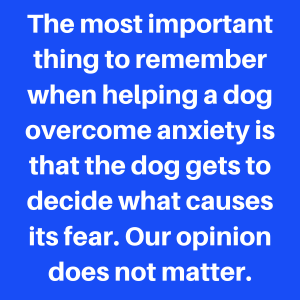
- Physical injury such as a fall, being hit by a car or being bitten by another animal.
- Physical abuse such as being hit or kicked by a person or being subjected to training methods and tools designed to force compliance through pain such as shock, prong, or choke collars.
- Emotional trauma is often associated with physical injuries and abuse. However, even yelling at a dog has the potential to create an unforgettable fear. Likewise, even angry body language expressed by a person can create emotional trauma.
Not all incidents of physical or emotional trauma will cause fear. Whether or not it does depends on the event, the individual dog, and its previous history.
The most important thing to remember when helping a dog overcome anxiety is that the dog gets to decide what causes its fear. Our opinion does not matter.
Addressing Fear – The first two steps in determining why your dog is fearful are; ruling out any potential genetic or medical issues. Neither training nor behavior modification will be helpful until the medical issues are resolved.
The third step is to manage the dog and its environment to prevent exposure to anything that could trigger their fear. In my experience, a well-designed behavior modification protocol and appropriate behavioral medications are almost always necessary when treating anxiety and aggression.
Recommended Resources
Articles on Don’s Blog
( http://www.words-woofs-meows.com )
Help! My Dog is Aggressive, Reactive, Fearful, Anxious, etc. – What do I do? – http://bit.ly/HelpDogAggx
How Can I Tell When My Dog Is Anxious or Fearful? – http://bit.ly/DogsSignsofFear
Essential Handouts On Body Language, and Canine and Human Behavior from Dr. Sophia Yin – https://bit.ly/YinBodyLang
Shared Blog Post – Reactivity Misunderstood – https://bit.ly/ReactivityMisunderstood
Shared Blog Post – the misunderstanding of time by Nancy Tanner – http://blog.greenacreskennel.com/2016/11/16/shared-blog-post-the-misunderstanding-of-time-by-nancy-tanner/
What Is A Pet Behavior Consultant? – http://bit.ly/WhatIsPetBhxConsulting
Understanding, Identifying and Coping with Canine Stress – http://bit.ly/Canine-Stress
The emotional toll of a reactive dog by Jay Gurden in Dog’s Today – http://bit.ly/SharedGurenEmotional
 Podcasts from The Woof Meow Show
Podcasts from The Woof Meow Show
( http://woofmeowshow.libsyn.com/ )
Canine Behavior: Myths & Facts – http://blog.greenacreskennel.com/2016/03/27/podcast-canine-behavior-myths-and-facts/
Pet Behavior, Vets & The AAHA Canine and Feline Behavior Management Guidelines with Dr. Dave Cloutier from Veazie Veterinary Clinic – http://blog.greenacreskennel.com/2016/03/13/podcast-the-woof-meow-show-pet-behavior-vets-the-aaha-canine-and-feline-behavior-management-guidelines-with-dr-dave-cloutier-from-veazie-veterinary-clinic/
Dog Training Questions for Don and Kate with special guest host Dr. Mark Hanks – part 3 – http://blog.greenacreskennel.com/2015/07/27/blog-post-27jul15-podcast-dog-training-questions-for-don-and-kate-with-special-guest-host-dr-mark-hanks-part-3/
The Unintended Consequences of Shock Collars – http://bit.ly/ShockPodcast
The Pet Professional Guild and the Shock-Free Coalition with Niki Tudge – http://bit.ly/PodCastShockFree-NikiTudge-2017
What’s Shocking About Shock – What Science Tells Us About the Use of Shock in Dog Training – http://bit.ly/WfMw-WhatShock-27JUL19
Podcast – Charlee and the Electronic Shock Containment System w-Dan Antolec – https://bit.ly/Blog-Charlee_E-Fence
To Find A Qualified and Credential Animal Behavioral Specialist
American College of Veterinary Behaviorists (ACVB) – https://www.dacvb.org/search/custom.asp
Animal Behavior Society ( ABS ) Certified Applied Animal Behavior Consultants – http://www.animalbehaviorsociety.org/web/applied-behavior-caab-directory.php
Pet Professional Accreditation Board (PPAB) – https://www.credentialingboard.com/Professionals
________________________________________________________________________
Don Hanson lives in Bangor, Maine, where he is the co-owner of the Green Acres  Kennel Shop ( greenacreskennel.com ) and the founder of ForceFreePets.com, an online educational resource for people with dogs and cats. He is a Professional Canine Behavior Consultant (PCBC-A) accredited by the Pet Professional Accreditation Board (PPAB) and a Bach Foundation Registered Animal Practitioner (BFRAP). Don is a member of the Pet Professional Guild (PPG), where he serves on the Board of Directors and Steering Committee and chairs the Advocacy Committee. He is also a founding director of Pet Advocacy International (PIAI). In addition, Don produces and co-hosts The Woof Meow Show podcast, available at http://bit.ly/WfMwPodcasts/, the Apple Podcast app, and Don’s blog: www.words-woofs-meows.com. The opinions in this post are those of Don Hanson.
Kennel Shop ( greenacreskennel.com ) and the founder of ForceFreePets.com, an online educational resource for people with dogs and cats. He is a Professional Canine Behavior Consultant (PCBC-A) accredited by the Pet Professional Accreditation Board (PPAB) and a Bach Foundation Registered Animal Practitioner (BFRAP). Don is a member of the Pet Professional Guild (PPG), where he serves on the Board of Directors and Steering Committee and chairs the Advocacy Committee. He is also a founding director of Pet Advocacy International (PIAI). In addition, Don produces and co-hosts The Woof Meow Show podcast, available at http://bit.ly/WfMwPodcasts/, the Apple Podcast app, and Don’s blog: www.words-woofs-meows.com. The opinions in this post are those of Don Hanson.
©22MAY22, Donald J. Hanson, All Rights Reserved
< Click for Copyright and Use Policy >
Shared Blog Post – Behavioral Euthanasia: Making the Hard Decision
Considering whether or not euthanasia is appropriate for a pet is never easy. However, it can be even more complicated when behavioral considerations are a primary factor in the process. Dr. Christine Calder, a veterinary behaviorist, recently addressed this topic in an article entitled Behavioral Euthanasia: Making the Hard Decision in the May 2022 edition of Downeast Dog News. If you face a decision of this nature, I encourage you to read the article, as Dr. Calder offers very sound advice and potential alternatives.
FMI – https://downeastdognews.villagesoup.com/p/behavioral-euthanasia-making-the-hard-decision/1907099
Shared Blog Post – You Have to Stop! Interrupting Unwelcome Puppy Play Toward an Older Dog from eileenanddogs.com
< A short link for this page – https://bit.ly/Shared-Pups-w-olderdogs >
Puppies can often be relentless when getting an older dog to play. While your senior dog may enjoy an opportunity to wrestle and play chase games with a puppy, odds are they will reach a point when they have had enough. Unfortunately, not all older dogs successfully tell the pup when to stop and, sadly, allow themselves to become miserable punching bags. In this blog post from Eileen Anderson, co-author of the fantastic book Puppy Socialization, she discusses how to deal with a pup harassing your older dog. –
Shared YouTube Post – LAST TRACK – Finding closure through dog tracking from HuntingME
< A short link for this page – https://bit.ly/LastTrack-3APR22 >
In addition to being great companions, dogs do some amazing things. In this 30-minute film from HuntingME, LAST TRACK – Finding closure through dog tracking, you will see “dog trackers Lindsay and Susanne as they help hunters of all ages track mortally wounded large animals across the great state of Maine. Their dogs Fritzi, Meggie and Aldo can track wounded game in a way that no human every could, combine that with the wealth of knowledge that Lindsay and Susanne have after over 2000 combined tracks and every hunter no matter their skill level can learn something from this film.”
Click to view the film on YouTube – https://youtu.be/_0_voikuxJM
One of the dog trackers in the film is Lindsay Ware, a part-time, Lead Dog Training Instructor for ForceFreePets.com and Green Acres Kennel Shop and the founder of Science Dogs of New England. Great job, Lindsay!
Contact Info for Lindsay Ware
United Blood Trackers
![]() Lindsay’s UBT Profile – https://www.unitedbloodtrackers.org/tracker-info/?user=216
Lindsay’s UBT Profile – https://www.unitedbloodtrackers.org/tracker-info/?user=216
-
- UBT Website – https://www.unitedbloodtrackers.org/
- Lindsay Ware, Large Game Blood Tracking on Facebook – https://www.facebook.com/pages/biz/Lindsay-Ware-Large-Game-Blood-Tracking-1404700653120812/
Science Dogs of New England
-
- Email: Email Lindsay
- Website: https://www.sciencedogsne.com/
- Facebook: https://www.facebook.com/ScienceDogsofNewEngland
Podcasts from The Woof Meow Show
( http://woofmeowshow.libsyn.com/ )
Using Dogs to Track Wounded Game with Lindsay Ware of United Blood Trackers –https://bit.ly/UnitedBloodTrackers-2018
Science Dogs of New England with Lindsay Ware, – 22FEB21 – http://bit.ly/WfMwSciDogs2020
Why I’m Seeking Credentialing from the Pet Professional Accreditation Board (PPAB)
< A short link for this page – https://bit.ly/DJH-PPAB >
I currently hold two dog training and behavior credentials. Unfortunately, the two organizations that issued those credentials believe that using a shock collar is acceptable. Their position is contrary to the science that indicates that aversives, such as shock, choke, and prong collars, are unnecessary and carry a significant risk of physical and emotional harm. To me, that is unacceptable. While I believe credentialing is vital to our profession, I am no longer comfortable being part of credentialing organizations that believe hurting pets in the name of care and training is okay. Therefore, I am seeking accreditation from the Pet Professional Accreditation Board (PPAB).
The PPAB believes that there is no place for shock, choke, prong, fear, or intimidation in canine training and behavior practices. They are not alone. The Pet Professional Guild (PPG), American Animal Hospital Association (AAHA), American Society of Veterinary Behavior (AVSAB), and Pet Industry Advocacy International (PIAI) have all taken positions, based on science, that state the use of aversive methods and tools in the training and care of pets is not only unnecessary but harmful.
I stand with those committed to the humane treatment of our pets and encourage all pet care professionals to join me. Using tools and methods designed to cause pets physical or emotional distress is NOT ethical pet care or training; it is abuse.
PPG – Pet Professional Guild Guiding Principles
AAHA – American Animal Hospital Association Canine and Feline Behavior Management Guidelines
AVSAB – American Veterinary Society of Animal Behavior Position Statement on Humane Dog Training
PIAI – A Coalition of informed, ethical and humane organizations
PPAB – https://www.credentialingboard.com/Accreditation-Board-Ethics-Code
Our Pets Most Important Nutrient – Water
 < A version of this article was published in the MAR22 issue of Downeast Dog News>
< A version of this article was published in the MAR22 issue of Downeast Dog News>
< Updated 04MAR22 >
< A short link for this page – https://bit.ly/Nut-Water >
The most important nutrient we provide for our pets is not the food we buy at the store or make from fresh ingredients. It is water. Water is also the most essential nutrient for people as well.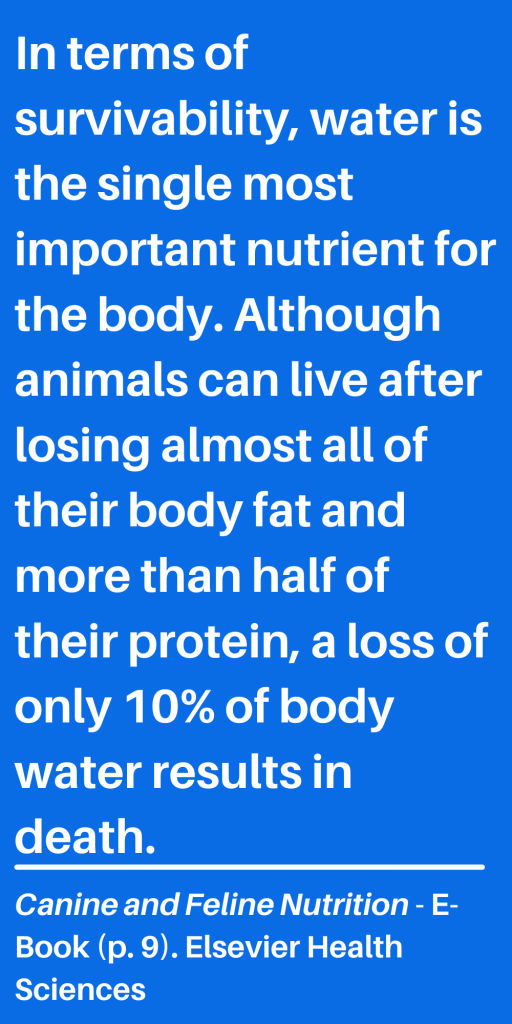
Water is a vital ingredient that fuels our bodies and keeps us alive. Without water, the cells in our body could not grow and reproduce. Water removes toxic wastes from our bodies via urine and helps lubricate our joints. Our body temperature is regulated by water and our brain uses water to produce hormones and neurotransmitters vital to our survival. The saliva we produce is an integral part of the digestive process. Is it any wonder that the human body is 60% water.
According to the American Journal of Clinical Nutrition, “The percentage of water in fat-free wet weight for most mature animals is estimated at 73.2%, although the mean values in the literature range from 63% for the beagle to 80% for the mouse, with the mean for the majority of species between 70 and 76%.” 1
Nature designed the dog and cat to get the bulk of the water they need from their food. While they may drink water we provide in a dish, cats less so than dogs; their body expects most of the water to be ingested with the food they consume.
Let’s look closer at the mouse, which is 80% water and also happens to be a common food source for feral canines and felines, either wild or domestic. The mouse is 80% water, and the rest is protein and fat – an optimal source of fresh nutrients for a dog or cat. I am not advocating we all start feeding our pets mice. However, we can use the mouse to compare the food we typically provide our pets. So, how much water is in our pet’s food? That depends on what we feed them.
Wet food, packaged in cans or pouches, is usually 70 to 75% moisture. Frozen raw food or lightly-cooked frozen food is about 60 to 70% moisture. So both wet and frozen foods are very close to meeting our pet’s water needs. However, before you immediately switch to these foods, understand that you need to look at the other ingredients. I feed my pets and recommend food with high moisture content and mostly meat (protein and fat) with minimal carbohydrates. Remember, neither the cat nor dog needs any carbohydrates in their diet. So basically, I want my pet’s food to mimic the composition of a mouse.
before you immediately switch to these foods, understand that you need to look at the other ingredients. I feed my pets and recommend food with high moisture content and mostly meat (protein and fat) with minimal carbohydrates. Remember, neither the cat nor dog needs any carbohydrates in their diet. So basically, I want my pet’s food to mimic the composition of a mouse.
Dry pet food; kibble, or freeze-dried and dehydrated foods contain 10 to 12% moisture. Manufacturers work very hard to keep that number low to prevent the food from spoiling. Yet, dry foods contain much less water than our pets’ bodies need. Kibble is also the most popular form of pet food due to its 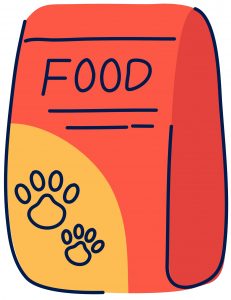 convenience and price compared to other options. Most freeze-dried and dehydrated food brands recommend you rehydrate the food before feeding it to your pet. If they didn’t, I would add water anyway. However, most kibble brands do not discuss the need to add water, which concerns me.
convenience and price compared to other options. Most freeze-dried and dehydrated food brands recommend you rehydrate the food before feeding it to your pet. If they didn’t, I would add water anyway. However, most kibble brands do not discuss the need to add water, which concerns me.
Our pet’s digestive system is designed to work best when digesting food that is 60% or more water. Digesting food with a low moisture content requires your pet to draw on the water reserves held in their cells. That can cause chronic dehydration. When I feed my dog Muppy, I always add water, no matter what type of food I am providing [ FMI – What I Feed My Dog and Why I Feed What I Do – https://bit.ly/WhatIFeedAndWhy ]
Boomer, my cat, is only fed wet food or frozen raw food with high moisture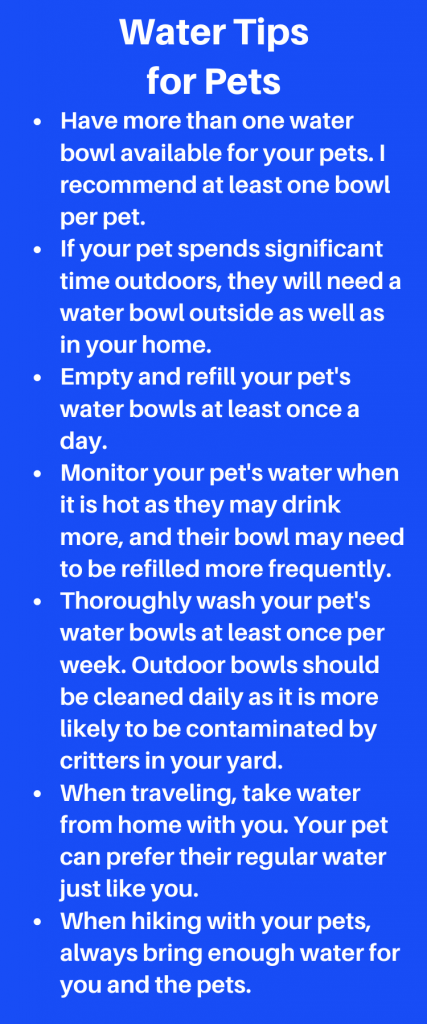 content. Cats are especially susceptible to dehydration as they are desert creatures who evolved to get almost all their water from food. Feeding a cat food with a minimal moisture content can cause a life-threatening medical condition called Urethral Obstruction. That is why I recommend that all cats be fed primarily with wet food.
content. Cats are especially susceptible to dehydration as they are desert creatures who evolved to get almost all their water from food. Feeding a cat food with a minimal moisture content can cause a life-threatening medical condition called Urethral Obstruction. That is why I recommend that all cats be fed primarily with wet food.
There are other benefits of adding water to your pet’s dry food. Water makes the food easier to chew and digest. If warm, the water creates a gravy, making the food more aromatic and palatable.
Be aware there is a myth that dry pet food will keep your pets’ teeth clean, but unless it is one of the special dental formulas, that, like all myths, is just not true. There are also much better ways to keep your pets’ teeth clean.
If you don’t want to add water to your pet’s kibble, consider bone broth, goat milk, fresh veggies (broccoli, kale, zucchini), fresh fruit like Maine blueberries, or a raw egg or some sardines. There are also many food supplements loaded with moisture and other vital micronutrients to consider.
Please, remember how important water is to your pet’s health. You will be glad you did.
Recommended Resources
Articles on Don’s Blog
( http://www.words-woofs-meows.com )
Pet Nutrition Facts – Do You Want Optimal Nutrition, Low Cost, or Convenience? You CANNOT Have It All – https://bit.ly/PetNut-Opt-Cost-Con
What I Feed My Dog and Why I Feed What I Do – https://bit.ly/WhatIFeedAndWhy
Podcasts from The Woof Meow Show
( http://woofmeowshow.libsyn.com/ )
 Podcasts-Two Conversations with Animal Nutritionist Dr. Richard Patton – http://bit.ly/WfMw2wPattonAPR21
Podcasts-Two Conversations with Animal Nutritionist Dr. Richard Patton – http://bit.ly/WfMw2wPattonAPR21
What We Feed Our Pets and Why, with – Don Hanson, Kate Dutra, and Linda Case – https://bit.ly/WfMw-WhatWeFeed-11JUL20
________________________________________________________________________
Don Hanson is the co-owner of the Green Acres Kennel Shop ( greenacreskennel.com ) in Bangor, Maine, where he has been helping people with their pets since 1995. He is also the founder of ForceFreePets.com, an online educational resource for people with dogs and cats. Don is a Bach Foundation Registered Animal Practitioner (BFRAP), Certified Dog Behavior Consultant (CDBC), Associate Certified Cat Behavior Consultant (ACCBC), and a Certified Professional Dog Trainer (CPDT-KA). He is a member of the Pet Professional Guild (PPG), where he serves on the Board of Directors and Steering Committee and chairs the Advocacy Committee and The Shock-Free Coalition ( shockfree.org ). In addition, Don produces and co-hosts a podcast, The Woof Meow Show, available at http://bit.ly/WfMwPodcasts/, the Apple Podcast app, and Don’s blog: www.words-woofs-meows.com. The opinions in this post are those of Don Hanson.
©01MAR22, Donald J. Hanson, All Rights Reserved
< Click for Copyright and Use Policy >
Pets & Automobiles – Helping Your Pet Enjoy the Car
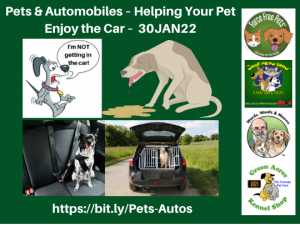 < A version of this article was published in the January and February 2022 issues of Downeast Dog News>
< A version of this article was published in the January and February 2022 issues of Downeast Dog News>
< Updated 30JAN22 >
< A short link for this page – https://bit.ly/Pets-Autos >
Cars, trucks, mini-vans, basically any automobile are often as much a part of our pets’ lives as they are ours. It’s how we brought them home the first time and transport them to all types of activities. We have all known someone who has a dog that the mere mention of “car ride” has the dog leaping in ecstasy. However, some dogs are or become terrified of riding in a moving vehicle. Some cats enjoy car rides, but many find the crate and car a predictor of getting sick or a trip to the vet.
Automobile Safety for Pets
We are responsible for the safety of our pets. Pets need to be secured in a vehicle when it is in motion for their safety and our own. A loose pet can become a distraction to the driver. A pet in the car’s front seat is unlikely to survive if the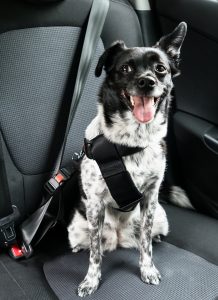 airbag discharges in an accident. An unsecured pet riding in a vehicle is more likely to become seriously injured. It also has great potential to hurt passengers if they become a fast-moving projectile due to a sudden stop. Even if a pet is uninjured in an accident, it is possible that they will be so terrified they will frantically try to escape, which itself can result in injury or death. Dogs have even been known to deter emergency personnel from rescuing injured people.
airbag discharges in an accident. An unsecured pet riding in a vehicle is more likely to become seriously injured. It also has great potential to hurt passengers if they become a fast-moving projectile due to a sudden stop. Even if a pet is uninjured in an accident, it is possible that they will be so terrified they will frantically try to escape, which itself can result in injury or death. Dogs have even been known to deter emergency personnel from rescuing injured people.
An article about car safety harnesses in the Whole Dog Journal, [Car Safety Harness Recommendation, updated 3/21/19], discusses a Boxer named Ruby riding in a car unrestrained when the vehicle was in an accident. Ruby survived but “…suffered a spinal cord injury and mild brain injury.” Ruby also required months of intensive rehab, costing over $9000.
One option for securing a pet in a vehicle is a hard-sided crate of the type used for air transport. The crate should be just big enough for your pet to stand up and lie down. A separate crate should be used for each pet. It would be best if you secure the crate to the vehicle chassis in a manner such that it cannot break loose in the event of an accident. An unsecured crate can become a dangerous projectile.
For a crate to effectively keep your pet safe and secure in your vehicle, your pet must be comfortable in their crate. Unfortunately, some pets find a crate 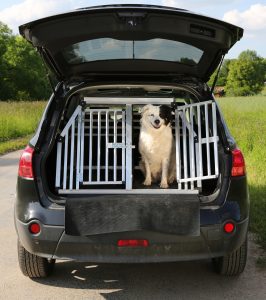 stressful, in which case you will need to patiently help them learn that a crate is a safe and comfortable place. These two articles can help you through the process; Dogs – Crate Habituation to Reduce Anxiety – http://bit.ly/CrateHabituation and Cats – Make Your Life Easier – Get Your Cat to Love Their Carrier – http://bit.ly/Cats-Carriers.
stressful, in which case you will need to patiently help them learn that a crate is a safe and comfortable place. These two articles can help you through the process; Dogs – Crate Habituation to Reduce Anxiety – http://bit.ly/CrateHabituation and Cats – Make Your Life Easier – Get Your Cat to Love Their Carrier – http://bit.ly/Cats-Carriers.
A gate or barrier is another option for securing a pet in a vehicle. However, for these to provide the safety necessary in an accident, they must be attached to the vehicle chassis so they cannot break free. While a barrier might keep passengers safe, it is no guarantee the pet will survive the crash.
Many people confine their dogs to the backseat of their car with a special harness or seatbelt made especially for dogs. Unfortunately, many of these products may not protect your dog in a crash, giving you a false sense of security. Only three such harnesses have passed the rigorous crash test standards of the Center for Pet Safety (CPS) [https://www.centerforpetsafety.org/] You can find a list of harnesses, carriers, and crates that are CPS Certified at https://www.centerforpetsafety.org/cps-certified/
While a CPS Certified harness can be an excellent option, recognize that your dog may not automatically enjoy being harnessed in the car. A reward-based dog trainer can help you slowly acclimate your dog to wearing such a harness in the car. FMI – How to Select A Dog Trainer – http://bit.ly/HowToSelectADogTrainer.
Does Your Pet Need to Go With You?
Most of us rarely take our cats for a ride because of most cats’ inherent dislike of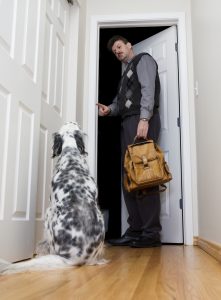 travel. On the other hand, many of us love our dogs’ company, and the dog often loves the adventure of a ride. However, suppose you will need to leave your dog alone in the vehicle at any time. In that case, I encourage you to ask yourself if having the dog with you is necessary.
travel. On the other hand, many of us love our dogs’ company, and the dog often loves the adventure of a ride. However, suppose you will need to leave your dog alone in the vehicle at any time. In that case, I encourage you to ask yourself if having the dog with you is necessary.
Unless the trip is specifically for the dog, a visit to daycare or the dog park, a hiking adventure appropriate for the dog, a trip to the veterinarian, or something else where the dog’s presence is required, I encourage you to consider leaving the dog at home. When we leave a dog alone in a vehicle, we need to worry about them; overheating, getting too cold, becoming anxious and frantically trying to escape, being stolen, or being teased by uncaring people. More than one person has told me how they caught a person taunting their dog when they left their dog alone in the car. After this, the dog behaved aggressively anytime anyone approached the vehicle. Another person told me they left their dog alone in the car for only a brief moment. However, it was enough time for the dog to bite a child when they stuck their little hand in through the open window. I love having Muppy with me, but if there is any chance I might need to leave her alone in the car, she stays home.
Aversion and Motion Sickness
A dog may suddenly refuse to get in the car for several reasons. The vehicle may have become a predictor of something unpleasant such as a trip to the  veterinarian. Or perhaps the dog was in the car during a traumatic event such as a crash or a thunderstorm. If the dog was injured getting in or out of a vehicle, they might also become afraid of the car. Even having an angry conversation with someone over your phone while the dog is in the vehicle may cause an aversion to being in the car.
veterinarian. Or perhaps the dog was in the car during a traumatic event such as a crash or a thunderstorm. If the dog was injured getting in or out of a vehicle, they might also become afraid of the car. Even having an angry conversation with someone over your phone while the dog is in the vehicle may cause an aversion to being in the car.
Nausea due to motion sickness is one of the biggest reasons dogs learn to dislike traveling. If the pet has little experience traveling, they may not be comfortable in motion, especially if confined in a crate or unable to see where they are going. Since you control the car’s movement, how you drive or where you drive may be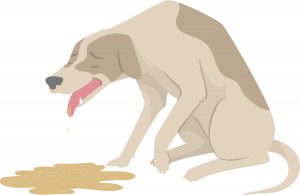 a factor. A queasy tummy may not be related to movement but may be triggered by something the dog ate. However, since the sick feeling started in the car, the dog may associate feeling queasy with the vehicle and not what they ate. Medical conditions such as an inner-ear problem may also cause nausea. However, no matter the cause, anything that causes physical or emotional pain or discomfort is likely to be remembered and is unlikely to resolve on its own. I encourage you to speak to your veterinarian or a credentialed animal behavior consultant as soon as possible for the sake of your pet.
a factor. A queasy tummy may not be related to movement but may be triggered by something the dog ate. However, since the sick feeling started in the car, the dog may associate feeling queasy with the vehicle and not what they ate. Medical conditions such as an inner-ear problem may also cause nausea. However, no matter the cause, anything that causes physical or emotional pain or discomfort is likely to be remembered and is unlikely to resolve on its own. I encourage you to speak to your veterinarian or a credentialed animal behavior consultant as soon as possible for the sake of your pet.
Two of my nine dogs went through periods of being uncomfortable in the car. When Tikken was a puppy, I started taking her on frequent short trips to acclimate her to travel. She was transported in a crate to keep her safe. These included a weekly trip to her vet for what I called a “happy visit,” where we walked in, I gave her a few treats, and then we left. One day I took her out of the crate when we got home, and I noticed she had drooled so profusely that her chest was soaked. The next time I tried to get her in the car, she sat down 20 feet away and refused to get any closer. The excessive drooling was a sign of nausea, and Tikken made it clear she did not want to get in the car again. I helped Tikken  learn that the vehicle was safe by stopping all travel until I successfully desensitized and counter conditioned her to like the car. A couple of months later, we took a 10-hour trip without incident.
learn that the vehicle was safe by stopping all travel until I successfully desensitized and counter conditioned her to like the car. A couple of months later, we took a 10-hour trip without incident.
My second dog to have issues in the car is my current dog, Muppy. The day we drove home with her, for three-plus hours, was without incident. However, soon after, she would occasionally vomit in the car about one out of every ten car rides. Fortunately, Muppy never became hesitant about getting in the vehicle. Still, her obvious discomfort and the profuse amounts of vomit motivated me to get her feeling comfortable. I was able to do so with some anti-nausea products. However, due to the unpredictability of her getting sick, it took a couple of years to figure it out.
If your dog is experiencing excessive drooling, vomiting, or diarrhea, specific to being in a moving vehicle, make an appointment with your veterinarian so that they can rule out any medical causes and prescribe any necessary medications.
How to tell if your dog is uncomfortable in the car
- Your dog is exhibiting signs of stress and discomfort in or around the vehicle ( FMI – http://bit.ly/DogsSignsofFear
- Your dog refuses to get in the car. Please understand making them get into the car will only make them more fearful of the car and you. It is not a solution.
- Your dog is smacking or licking its lips or drooling excessively, indicating they may feel nauseous or anxious.
- Your dog is vomiting or has diarrhea when in the car; both can be a sign of nausea or anxiety.
Things that may help alleviate nausea and anxiety
- Limit trips to only those that are necessary until the issue is resolved.
- Withhold food and treats at least 12-hours before necessary travel.
- Practice very short trips in the vehicle; 30ft, 60ft, 100ft, increasing in small increments. You might want to consult with a credentialed pet behavior consultant to assist you with developing a desensitization protocol.
- Treat nausea and, if necessary, anxiety.
- Over the counter treatments (No Prescription Required)
- Ginger helps relieve nausea. The easiest way to see if it helps your dog is to get some gingersnap cookies. Just make sure they contain real ginger and do not contain xylitol. Give a cookie about 30-minutes before travel.
- CBD can relieve both anxiety and, in some cases, nausea. It is one of the things I use with Muppy. Just be careful as there is a wide range of CBD products, and not all of them are of equal quality. ( FMI – http://bit.ly/BLOG-Hemp-CBD-PRO-for-pets )
- Adaptil – This is a pheromone that can help alleviate anxiety. It is available as a spray and a collar.
- Lavender Essential Oil – Lavender can have a calmative effect. Still, just as with CBD, there are many Lavender products, and they are not all of the same grade and quality.
- Bach Rescue Remedy – Rescue Remedy® is a combination flower remedy formula explicitly created for addressing stress in emergencies or crises. I have used it for over 20 years in a wide variety of applications. ( FMI – http://bit.ly/Bach-RescueRemedy )
- Homeopathic Remedies – While many homeopathic medications do not require a prescription, I recommend that you work with a Homeopathic Veterinarian if you are not knowledgeable in this area. Some remedies can be beneficial in treating nausea and motion sickness. One was very helpful with Muppy. Dr. Herman, who also writes a column for Down East Dogs News, is knowledgeable about using homeopathic remedies with pets.
- Prescription medications – (Must be prescribed by a veterinarian). Only treating nausea may be enough, but symptoms of nausea may predict anxiety, so an anti-anxiety medication may also be in order. Common medications prescribed by veterinarians for these conditions include:
- for nausea – Cerenia®, Antivert®, and Bonine®
- for anxiety – Alprazolam (Xanax®), trazodone (Desyrel®)
- Please do not use any prescription medication with your pet without first discussing it with your veterinarian.
- Behavior Modification – A desensitization and counterconditioning protocol, such as I used with Tikken, may be helpful or even necessary to get the dog to tolerate or enjoy the car after a bad experience. A credentialed dog behavior consultant or Veterinary Behaviorist such as DEDN columnist Dr. Christine Calder can help. ( FMI – http://bit.ly/WWM-Trainer-Behaviorist )
- Over the counter treatments (No Prescription Required)
Recommended Resources
Articles on Don’s Blog
( http://www.words-woofs-meows.com )
Dogs – Crate Habituation to Reduce Anxiety – http://bit.ly/CrateHabituation
Cats – Make Your Life Easier – Get Your Cat to Love Their Carrier – http://bit.ly/Cats-Carriers.
How to Choose A Dog Trainer – http://bit.ly/HowToSelectADogTrainer
How Can I Tell When My Dog Is Anxious or Fearful? – http://bit.ly/DogsSignsofFear
How Hemp-Derived Phytocannabinoid Nutraceuticals May Help Your Pets – http://bit.ly/BLOG-Hemp-CBD-PRO-for-pets
Bach Flower Remedies – Bach Rescue Remedy® – http://bit.ly/Bach-RescueRemedy
Do I Need a Dog Trainer or a “Behaviorist”? – http://bit.ly/WWM-Trainer-Behaviorist
Contact Information for Dr. Herman & Dr. Calder
Dr. Judy Herman
Animal Wellness Center
95 Northern Ave., Augusta ME
207-623-1177
http://www.judithhermandvm.com/
Dr. Christine Calder
Calder Veterinary Behavior Services
207-298-4375
www.caldervbs.com
________________________________________________________________________
Don Hanson is the co-owner of the Green Acres Kennel Shop ( greenacreskennel.com ) in Bangor, Maine, where he has been helping people with their pets since 1995. He is also the founder of ForceFreePets.com, an online educational resource for people with dogs and cats. Don is a Bach Foundation Registered Animal Practitioner (BFRAP), Certified Dog Behavior Consultant (CDBC), Associate Certified Cat Behavior Consultant (ACCBC), and a Certified Professional Dog Trainer (CPDT-KA). He is a member of the Pet Professional Guild (PPG), where he serves on the Board of Directors and Steering Committee and chairs the Advocacy Committee and The Shock-Free Coalition ( shockfree.org ). In addition, Don produces and co-hosts a podcast, The Woof Meow Show, available at http://bit.ly/WfMwPodcasts/, the Apple Podcast app, and Don’s blog: www.words-woofs-meows.com. The opinions in this post are those of Don Hanson.
©23JAN22, Donald J. Hanson, All Rights Reserved
< Click for Copyright and Use Policy >
Shared Blog Post – All About Hypoallergenic Dog Breeds – They’re NOT!
< A short link for this page – https://bit.ly/AreDogsHypoallergenic >
Many people desperately want a dog in their life but have allergies. There are dog breeds advertised and promoted as being “hypoallergenic.” This would seem to imply that if you get one of these dogs, you will not have an allergic reaction. Sadly, the very suggestion that a dog is “hypoallergenic” is disingenuous. As noted in this recent blog post by Embark, “Being called hypoallergenic means the dog is less likely to cause someone to have an allergic reaction. However, no dog is 100% hypoallergenic.”
If you are searching for a “hypoallergenic” dog, I encourage you to read this blog post from Embark. It provides detailed, scientific information on dog allergies and which breeds may be less of a concern than others for a person that has dog allergies. However, the fact remains no dog will be 100% allergenic.
Embark – All About Hypoallergenic Dog Breeds – https://embarkvet.com/resources/blog/all-about-hypoallergenic-dog-breeds/?
If you are thinking about buying a dog from someone telling you that the dog is “hypoallergenic,” I suggest you talk to other breeders, rescues, and pet professionals before making a financial commitment. At least, ask yourself, “What else have they told me about this dog that might not be true?” The following article from my blog may be helpful as you look for the right dog for you and your family.
Adopting A Pet – Finding the Right Dog for You and Your Family – http://bit.ly/FindingTheRightDogForYou
Shared Blog Post – Reactivity:Misunderstood
< A short link for this page – https://bit.ly/ReactivityMisunderstood >
I found this excellent graphic on Facebook, which does an excellent job of describing dog reactivity and aggression. Thank you to the Dancing Zombie Design Studio for creating it and Calvert Canines – Training, Behaviour Modification & Nutrition for sharing it.
Recommended Resources
Articles on Don’s Blog
( http://www.words-woofs-meows.com )
Help! My Dog is Aggressive, Reactive, Fearful, Anxious, etc. – What do I do? – http://bit.ly/HelpDogAggx
How Can I Tell When My Dog Is Anxious or Fearful? – http://bit.ly/DogsSignsofFear
Dog Training – Reward Based Training versus Aversives – http://bit.ly/RewardVSAversive
Shared Blog Post – Why Counterconditioning “Doesn’t Work” or How to Help Ensure Counterconditioning Will Work – http://blog.greenacreskennel.com/2021/11/11/shared-blog-post-why-counterconditioning-doesnt-work-or-how-to-help-ensure-counterconditioning-will-work/
Shared Blog Post – the misunderstanding of time by Nancy Tanner – http://blog.greenacreskennel.com/2016/11/16/shared-blog-post-the-misunderstanding-of-time-by-nancy-tanner/
What Is A Pet Behavior Consultant? – http://bit.ly/WhatIsPetBhxConsulting
Introduction to Canine Communication – http://bit.ly/CanineComm
Dominance: Reality or Myth – http://bit.ly/Dominance-RealityorMyth
Understanding, Identifying and Coping with Canine Stress – http://bit.ly/Canine-Stress
Canine Behavior – Myths and Facts – Part 1, Where do we get our knowledge about dogs? – http://blog.greenacreskennel.com/2016/05/04/canine-behavior-myths-and-facts-part-1-where-do-we-get-our-knowledge-about-dogs/
Green Acres Kennel Shop Position Statement on the Use of Dominance and Punishment for the Training and Behavior Modification of Dogs – http://bit.ly/GAKS-Pos-NoPain-NoForceNoFear
The Unintended Consequences of Shock Collars – http://bit.ly/ShockCollars
The emotional toll of a reactive dog by Jay Gurden in Dog’s Today – http://bit.ly/SharedGurenEmotional
Important Position Statements Related to Animal Welfare & Care in the USA by Leading Organizations – https://bit.ly/Pos_HumaneTraining
What’s Shocking about Shock? – What Science Tells Us About the Use of Shock in Dog Training – PPG BARKS from the Guild – July 2019 – http://bit.ly/ShockBARK-JUL2019
Things I Wish I Had Known Before I Started Training Dogs – Gus, the Dominance Myth, An Alpha Roll, and a Damaged Relationship – WWM-SEP2018 – http://bit.ly/Things-Gus-Dominance
Things I Wish I Had Known Before I Selected My First Dog – Aversives are Unnecessary and Counter-Productive When Training A Dog – Part 1 – WWM-JAN2019 – http://bit.ly/Things-Aversives-1
Things I Wish I Had Known Before I Selected My First Dog – Aversives are Unnecessary and Counter-Productive When Training A Dog – Part 2 – WWM-FEB2019 – http://bit.ly/Things-Aversives-2
Choke Collar Pathology – an excellent blog post from dog trainer Daniel Antolec on the dangers of using a choke collar on a dog. – http://ppgworldservices.com/2017/06/13/choke-collar-pathology/
Podcasts from The Woof Meow Show
( http://woofmeowshow.libsyn.com/ )
Canine Behavior: Myths & Facts – http://blog.greenacreskennel.com/2016/03/27/podcast-canine-behavior-myths-and-facts/
Pet Behavior, Vets & The AAHA Canine and Feline Behavior Management Guidelines with Dr. Dave Cloutier from Veazie Veterinary Clinic – http://blog.greenacreskennel.com/2016/03/13/podcast-the-woof-meow-show-pet-behavior-vets-the-aaha-canine-and-feline-behavior-management-guidelines-with-dr-dave-cloutier-from-veazie-veterinary-clinic/
Dog Training Questions for Don and Kate with special guest host Dr. Mark Hanks – part 3 – http://blog.greenacreskennel.com/2015/07/27/blog-post-27jul15-podcast-dog-training-questions-for-don-and-kate-with-special-guest-host-dr-mark-hanks-part-3/
The Unintended Consequences of Shock Collars – http://bit.ly/ShockPodcast
The Pet Professional Guild and the Shock-Free Coalition with Niki Tudge – http://bit.ly/PodCastShockFree-NikiTudge-2017
What’s Shocking About Shock – What Science Tells Us About the Use of Shock in Dog Training – http://bit.ly/WfMw-WhatShock-27JUL19
Podcast – Charlee and the Electronic Shock Containment System w-Dan Antolec – https://bit.ly/Blog-Charlee_E-Fence
Handouts to Download
Dr. Sophia Yin – Body Language of Fear in Dogs – http://info.drsophiayin.com/free-poster-on-body-language-in-dogs
Dr. Sophia Yin – How To Greet A Dog and What to Avoid – https://drsophiayin.com/blog/entry/preventing-dog-bites-by-learning-to-greet-dogs-properly/
Dr. Sophia Yin – Canine Bite Levels – http://info.drsophiayin.com/download-the-bite-levels-poster
To Find A Qualified and Credential Animal Behavioral Specialist
American College of Veterinary Behaviorists (ACVB) – https://www.dacvb.org/search/custom.asp
Animal Behavior Society ( ABS ) Certified Applied Animal Behavior Consultants – http://www.animalbehaviorsociety.org/web/applied-behavior-caab-directory.php
International Association of Animal Behavior Consultants ( IAABC ) – http://iaabc.org/consultants
Pet Professional Accreditation Board (PPAB) – https://www.credentialingboard.com/Professionals
